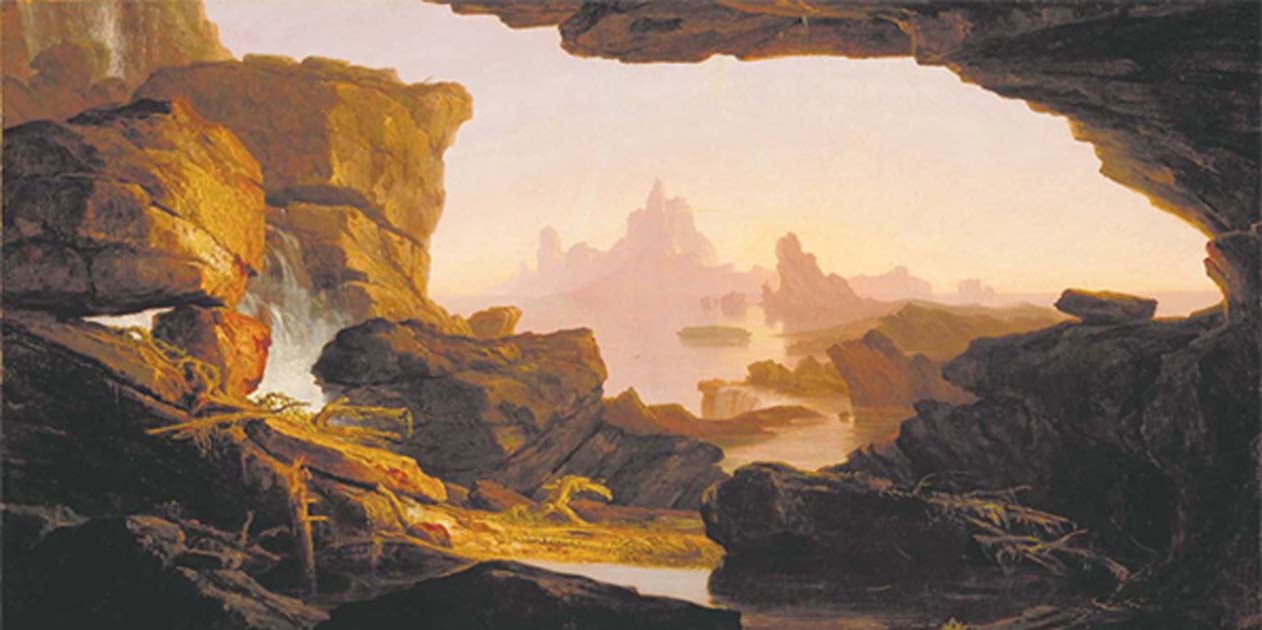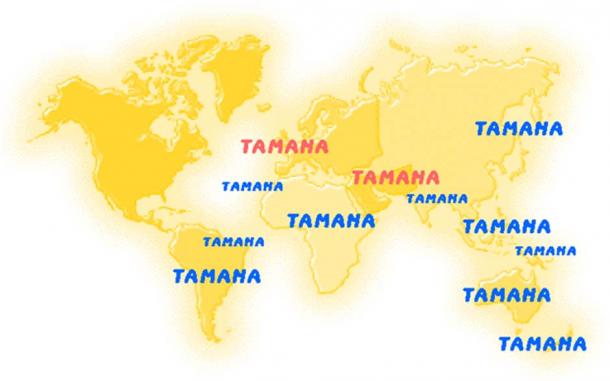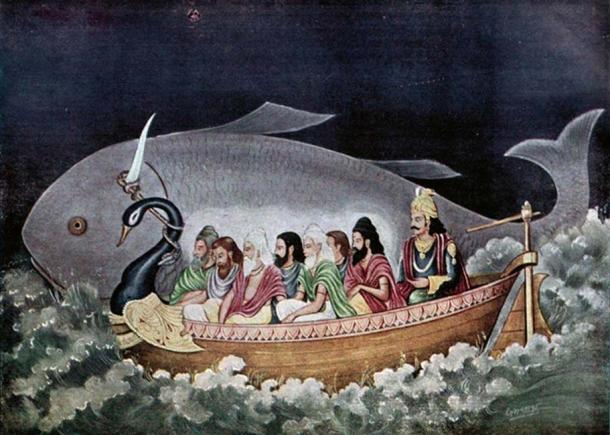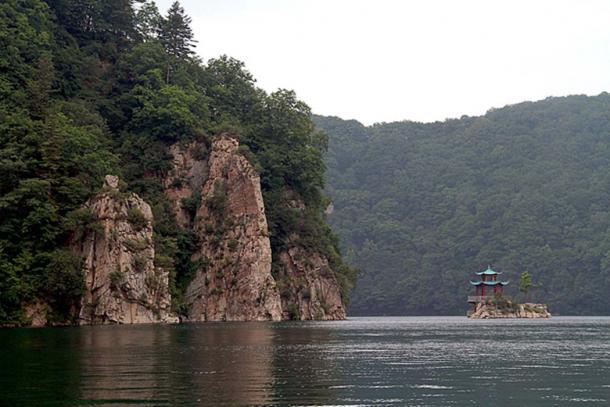Was Tamana a Universal Civilization of Mankind Before the Great Flood?

Was there once a Universal World Culture? A researcher in Hawaii, Dr. Vomos-Toth Bator argued there was such a culture, and he presented over 1,000,000 place names from around the world to prove his point.
Ancient Civilization
At Borota-Kukula in Hungary, Borota near Lake Chad in Africa, Kukura, Bolivia and Kukula, New Guinea we find Cone-Houses of similar shapes. In addition, Dr. Vamos Toth found 6000-year-old pottery signs from sites such as Tordos in the Carpathian Basin of Europe, ancient Egypt, and Banpo in China all showing amazing correspondence. Toth explains that the appearance of identical place-names in different parts of the world is evidence of an ancient civilization that formerly existed that he called Tamana.

Image courtesy Clyde Winters
All of these similarities in place-names and cultural expressions, separated by thousands of miles suggested to Toth that at some time in our distant past mankind shared a universal culture. He believed he had found this Universal culture which spanned the entire world untold millennia before our present era. Toth called this pre-Diluvial culture: Tamana, the name these ancient civilizers used to denote their colonial cities.
Over a decade ago Toth observed that certain place-names common to his ancestral home in the Carpathian Basin of his beloved Hungary, were also found in countries outside of Europe. After years of research he discovered that 5800 places names are found in the Carpathian Basin and 149 countries around the world. Over 3500 of these place names can be seen outside of Eurasia, in Africa, the Americas and Oceania. Most of these towns and rivers that share Tamana place names are found in areas recently discovered or geographically not known even 100-150 years ago.

Map of places around the world named Tamana (Courtesy author)
Topographical names rarely change; even though new peoples may settle in an area. For example, my home town of Chicago still bears a name originally given the area by its former Native American inhabitants.
Tamana – Original Settlement
The term Tamana is a place name found in 24 countries around the world. Toth discovered the occurrence of this place name as a river in Northern Ontario: Tamuna (< Tamana). This place-name situated in a secluded swampy area near the Hudson Bay, is an infusive-superfusive survival of the word Tamana.

Tamana world map (Courtesy author)
The term Tamana in the Manding language of Africa, the Magyar language of Hungary and the Dravidian languages spoken in India share the same meaning: “Strong Place, Stronghold’ or ‘Original Settlement. Since the cities established by the Tamana people were cities or trading centers situated among hostile tribes led to these settlements being called: Tamana or ‘stronghold’.
The Deluge
The Tamana people may have come from Saharan Africa, because they appear to have expanded around the world after the Deluge, which some researchers like Zecharia Sitchin, who in his book When Time Began, believe occurred 13,000 years ago. Sitchin believes that 13,000 years ago climatic changes occurred after the Antarctica ice sheet melted and sent a giant tidal wave, destroying low-land areas throughout the world.
There is considerable mention of a great deluge in the legends and ancient lore of almost all the peoples on the planet. In the Hebrew Bible, we find the biblical account of Noah, who was told by god to build an ark to carry the remnants of mankind and the animals of the earth.
In the Mesopotamian cuneiform writing there is also mention of the great deluge. In the Mesopotamia account of the deluge the Sumerian god Enki, told Atra Hasis to build a boat to save mankind during a great flood that lasted days. And in India we find mention of the god Manu, who is supposed to have saved mankind after a similar great flood.

Manu and the seven sages at the time of Deluge. (Public Domain)
All of these stories have a common theme. That theme is the presence in ancient times of pluvial climate which led to mankind learning more about the navigation of the seas, and boat building.
It would appear that because of the world wide flooding of low land areas, the only safe place to live at this time may have been the highland areas of Saharan Africa. It is this theory which has led to the Tamana culture bearers being called Proto-Saharans.
Ancient Navigators
It would appear the Tamana people belonged to an ancient confederation called Maa. Members of the Maa or Fish Confederation include the Magyar, Egyptians, Elamites, Manding, Afro-Asiatic speakers and the Dravidians.
The name Maa was either their great ancestor Noah, Atra Hasis, etc., or the god worshipped by these ancient navigators. In honor of this great ancestor the descendants of the Tamana people used the term ma, to denote ‘greatness or highness’. For example the term for ‘great’ is, Magyar:Maga- s; Manding Maga; and Dravidian Ma.
The Tamana people also claim descent from the great Maa, founder of the Fish Confederation. For illustration, the Manding or Mandikan people call themselves Ma-nde (the children of Ma); the Sumerians called themselves Mah-Gar-ri (exalted children); while the Magyar refer to themselves as Muh-ger-ri (Mogeri) or Ma-ka-r (exalted children).

Sculpture of the Manding, a family of ethnic groups in West Africa. (CC BY-SA 3.0)
The research of Dr. Vamos-Toth Bator indicates that the Tamana had their own writing as proven by the similarity of the pottery writing found on ancient samples from Africa and Eurasia. In addition, they possessed an outstanding boat technology and knowledge of nautical astronomy. These Proto-Saharans offered prayers to Ka ‘the ancient spirit/God’: Magyar Kan; Mandikan Kani; and Dravidian Ka-n.
Global Toponyms
Toth, after years of research has found the missing link in ancient history, that is numerous global toponyms that point to a common origin around the world. Although many scholars would dispute this claim right away without reviewing the evidence, the results of Toth’s research, when viewed with an open mind and including the hundreds of toponyms that he has discovered, shows a link between place-names in Africa, Eurasia and the Americas, that deserves to be examined by other academics.
A key element of Vamos Toth’s research has been the discovery of regularity of prefixed or suffixed place-name elements. The use of this method is not new. It was also used by Allen Mawer, in 1924 in his book The Chief Elements Used in English Place-Names.
The toponymic data collected by Toth compliments the work of N.Lahovary, who in Dravidian Origins and the West made factual claims about the common origin of pre-Indo-European cultures in Europe and Asia. The discovery of the -ari element in many toponymic examples is significant because ari, agrees with ur, the Dravidian suffix for ‘city, village or town’. In Sumerian ur/ uru, has a similar meaning. This corresponds to terms in the Manding languages where we have furu, or ‘property of a clan’. This compliments the findings of Lahovary of the widespread use of ar, among the hydronomic names from Europe to India.
Toth gives many Tamana place-names with the ma- element. This agrees with the Manding word ma: ‘area’ or ‘surface’, this corresponds to the Dravidian word man : ‘earth’, ‘soil’ and ‘land’.
Another common place-name element recognized by Toth is ka and ki. The ka element seems to represent an inhabited area. For example, in the Dravidian languages ka means fortification, in Manding languages -ka, is a locative suffix joined to place-names, while in Swahili ka means ‘to live (in), dwell. In Sumerian, -ki, is the past position determinative placed after the name of places and countries.
The final Tamana place-name elements covered by Thoth are: gu,nu, Bum and Buna. These terms, from the study of the languages spoken by the Tamana culture, were used to refer to home or domicile. For example, the bo or bu element is often found in the terms for house; for example, Kannada gibu is ‘house’ and Manding bo is ‘house’. The nu element can be found in many languages as n+vowel, for instance, Dravidian nakar is ‘house’, Manding nu is ‘habitation of a family or clan’.
The Dravidian term mal, or mala was a common root in the toponyms of the Near East, Europe, India and Mexico. In the Dravidian languages mala means mountain, or hill or large rough rocks. In the Magyar language, a member of the Ural-Altaic group mal means ‘pile, stack, heap and hill’.

The Indus Valley civilization (2,600-1,900 BCE) located both in Pakistan and India is often identified as having been Dravidian. The Pashupati seal from the Indus Valley Civilization. (Public Domain)
The Dravidian, Manding and Ural Altaic languages can explain the place names ‘sand’ and ‘kara’. The kara term is most interesting. This name is very popular especially in Inner Asia. This term occurs as a name for towns situated along rivers, streams or lakes. This suggests that kara is a water sign.
This view is supported by the Manding and Dravidian languages. In Dravidian ‘car’ means “unite and shelter”, while kar means “saltiest or brackish’. In Manding kara means “to assemble, and be dirty”. This suggests that the kara toponym was used to name towns, because it signified both a place of assembly (shelter), and a place where the water would be brackish or dirty. In the Dravidian languages kari, meant river. The term kara is often associated dirt or black, for example Turkish kara is ‘black’, Magyar korom ‘soot, dirty’ and Korean kurim ‘soot’.
- Startling Similarity between Hindu Flood Legend of Manu and the Biblical Account of Noah
- Did Paleoamericans Reach South America First?
- Buddhism in Ancient Egypt and Meroe – Beliefs Revealed Through Ancient Script
The sand, place name appears to denote dry uncultivated land near a river at high altitude areas of the globe. Sand, may agree with Manding sade ‘uncultivated land in the region where rain is formed (the mountains)’. This interpretation is based on the reading of sa and nde. In Manding sa, means ‘serpent, rain, sky region where rain is formed’ and nde ‘uncultivated land near water’. It is interesting to note that -sa, -csa in Magyar means ‘pond, dirty lake’.
Since the tops of mountains are usually covered by (rain) clouds, it meant when people living in the valleys moved their habitation sites up into the mountainous areas near rivers they would call these sites sa- nde ‘the sky region’s land near water’. This view is supported by the fact that in Chinese, shan means ‘mountain range’, while shandi meant ‘hilly land’, this totally agrees with our interpretation of the term sa-nde. In the Chinese language shang would agree with sand, because shang means ‘upper’. In Magyar, the word sand (shand) means ‘slant of the mountains’.

Mountain range and Sanjiaolong Crater Lake in the Longwanqun National Forest Park, Huinan County, Jilin, China. (CC BY-SA 3.0)
Another Tamana place name is assa. The term assa, is related to water. In many ancient languages ba and a, were used to denote water. Many Manding and Dravidian words formed with an initial s(c)- today, in ancient times were formed by an initial t-. In Dravidian, Magyar and Manding ta-, indicates places. In Mandi- ng -sa, in ancient times was used to denote a place of habitation. Thus assa, could be interpreted as ‘water place or locality of water’. The addition of the -s, after a-, in the term assa, is nothing more than a verbal termination. Thus if sand-assa, is near a body of water it can be interpreted as ‘mountainous region of land near water’, or ‘much water this locality’.
Another Tamana place name was assa-ker. The term assa-ker means ‘brackish water this locality’ or ‘ much water this locality of the brackish type’.
Connections around the World
The evidence is clear, many place names in Eurasia, Africa and the Americas are substrates that are derived from the languages spoken by the Tamana people which include Sumerian, Magyar, Mandikan and the Dravidian group. The toponyms discovered by Dr. Vamos-Toth also highlight the wide dispersal of the Tamana people in ancient times and the origination of the substantial Nostratic vocabulary that link widely dispersed languages from Africa, to Eurasia and the Americas.
Related Post
A shocking documentary proves that mermaids do exist
SHOCKING Revelation: Thuya, Mother of Queen Tiye, Was the Grandmother of Akhenaten and Tutankhamun—What Ancient Egyptian Secrets Did She Leave Behind?
Breaking News: Astonishing Discoveries at Karahan Tepe Confirm an Extraterrestrial Civilization is Hiding on Earth, and NO ONE Knows!
Breaking News: Researchers FINALLY Discover U.S. Navy Flight 19 After 75 Years Lost in the Bermuda Triangle!
NASA’s Secret Investigation: Uncovering the Astonishing Mystery of the UFO Crash on the Mountain!
Explosive UFO Docs LEAKED: Startling Proof That Aliens Ruled Ancient Egypt!